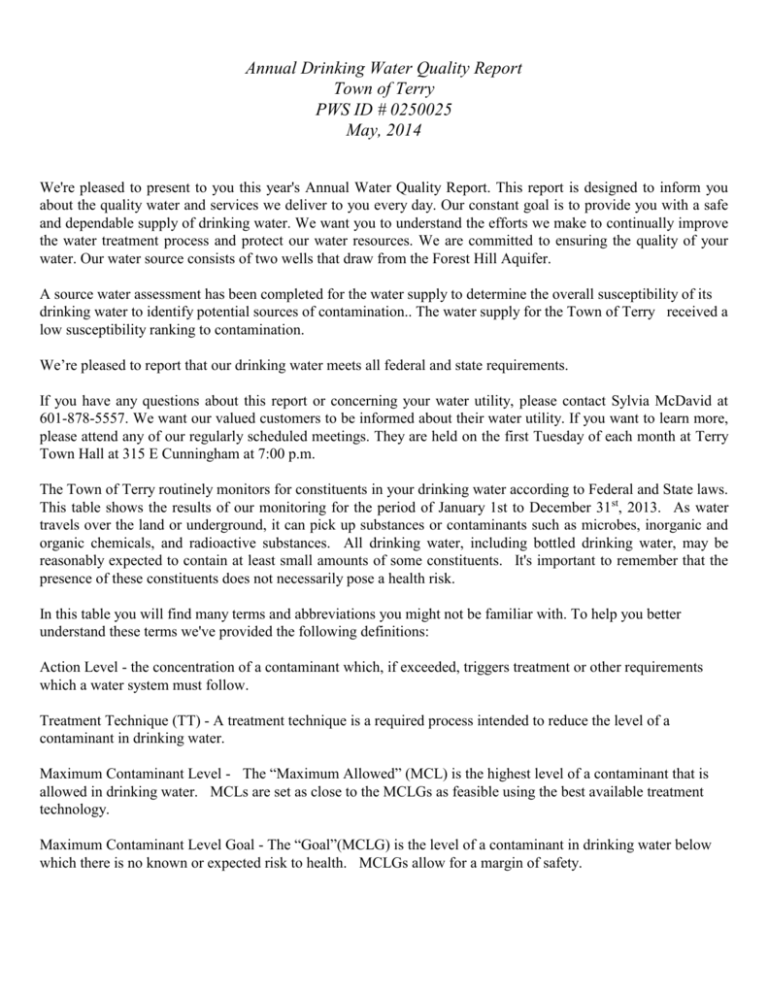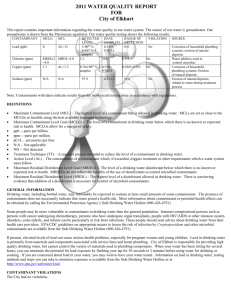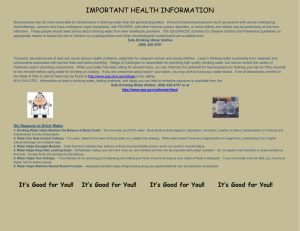irections for completing
advertisement

Annual Drinking Water Quality Report Town of Terry PWS ID # 0250025 May, 2014 We're pleased to present to you this year's Annual Water Quality Report. This report is designed to inform you about the quality water and services we deliver to you every day. Our constant goal is to provide you with a safe and dependable supply of drinking water. We want you to understand the efforts we make to continually improve the water treatment process and protect our water resources. We are committed to ensuring the quality of your water. Our water source consists of two wells that draw from the Forest Hill Aquifer. A source water assessment has been completed for the water supply to determine the overall susceptibility of its drinking water to identify potential sources of contamination.. The water supply for the Town of Terry received a low susceptibility ranking to contamination. We’re pleased to report that our drinking water meets all federal and state requirements. If you have any questions about this report or concerning your water utility, please contact Sylvia McDavid at 601-878-5557. We want our valued customers to be informed about their water utility. If you want to learn more, please attend any of our regularly scheduled meetings. They are held on the first Tuesday of each month at Terry Town Hall at 315 E Cunningham at 7:00 p.m. The Town of Terry routinely monitors for constituents in your drinking water according to Federal and State laws. This table shows the results of our monitoring for the period of January 1st to December 31st, 2013. As water travels over the land or underground, it can pick up substances or contaminants such as microbes, inorganic and organic chemicals, and radioactive substances. All drinking water, including bottled drinking water, may be reasonably expected to contain at least small amounts of some constituents. It's important to remember that the presence of these constituents does not necessarily pose a health risk. In this table you will find many terms and abbreviations you might not be familiar with. To help you better understand these terms we've provided the following definitions: Action Level - the concentration of a contaminant which, if exceeded, triggers treatment or other requirements which a water system must follow. Treatment Technique (TT) - A treatment technique is a required process intended to reduce the level of a contaminant in drinking water. Maximum Contaminant Level - The “Maximum Allowed” (MCL) is the highest level of a contaminant that is allowed in drinking water. MCLs are set as close to the MCLGs as feasible using the best available treatment technology. Maximum Contaminant Level Goal - The “Goal”(MCLG) is the level of a contaminant in drinking water below which there is no known or expected risk to health. MCLGs allow for a margin of safety. TEST RESULTS Contaminant Violation Y/N Date Collected Level Detected Range of Detects or # of Samples Exceeding MCL/ACL Unit Measurement MCLG MCL Likely Source of Contamination Inorganic Contaminants 10. Barium N 2012* 0.00404 No Range Ppm 2 14. Copper N 0.1 None ppm 1.3 16. Fluoride N 1/1/09 to 13/31/11* 2012* 0.204 No Range ppm 4 17. Lead N 3 None ppb 0 ppm 4 ppb 0 80 By-product of drinking water chlorination ppb 0 60 By-product of drinking water chlorination 1/1/09 to 12/31/11* 2 Discharge of drilling wastes; discharge from metal refineries; erosion of natural deposits AL=1.3 Corrosion of household plumbing systems; erosion of natural deposits; leaching from wood preservatives 4 Erosion of natural deposits; water additive which promotes strong teeth; discharge from fertilizer and aluminum factories AL=15 Corrosion of household plumbing systems, erosion of natural deposits Disinfectants & Disinfectant By-Products Chlorine (as Cl2) N N 1/1/13 to 12/31/13 2011* 73. TTHM [Total trihalomethanes] HAA5 0.80 16.57 0.30 to 1.20 None N 2011* 12 None 4 Water additive used to control microbes * Most recent sample results available Additional Information for Lead If present, elevated levels of lead can cause serious health problems, especially for pregnant women and young children. Lead in drinking water is primarily from materials and components associated with service lines and home plumbing. The Town of Terry is responsible for providing high quality drinking water, but cannot control the variety of materials used in plumbing components. When your water has been sitting for several hours, you can minimize the potential for lead exposure by flushing your tap for 30 seconds to 2 minutes before using water for drinking or cooking. If you are concerned about lead in your water, you may which to have your water tested. Information on lead in drinking water, testing methods, and steps you can take to minimize exposure is available from the Safe Drinking Water Hotline or at http://www.epa.gov/safewater/lead. The Mississippi State Department of Health Public Health Laboratory offers lead testing for $10 per sample. Please contact 601.576.7582 if you wish to have your water tested.. All sources of drinking water are subject to potential contamination by substances that are naturally occurring or man made. These substances can be microbes, inorganic or organic chemicals and radioactive substances. All drinking water, including bottled water, may reasonably be expected to contain at least small amounts of some contaminants. The presence of contaminants does not necessarily indicate that the water poses a health risk. More information about contaminants and potential health effects can be obtained by calling the Environmental Protection Agency’s Safe Drinking Water Hotline at 1-800-426-4791. Some people may be more vulnerable to contaminants in drinking water than the general population. Immuno-compromised persons such as persons with cancer undergoing chemotherapy, persons who have undergone organ transplants, people with HIV/AIDS or other immune system disorders, some elderly, and infants can be particularly at risk from infections. These people should seek advice about drinking water from their health care providers. EPA/CDC guidelines on appropriate means to lessen the risk of infection by cryptosporidium and other microbiological contaminants are available from the Safe Drinking Water Hotline (800-426-4791). This report being published in the paper will not be mailed. If you have any questions or would like a copy please call our office.







